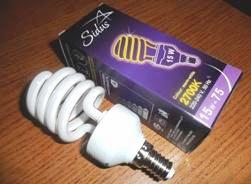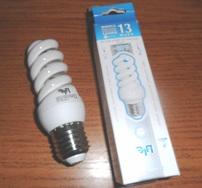Categories: Featured Articles » Sources of light
Number of views: 126579
Comments on the article: 11
Ten Frequently Asked Questions About Energy Saving Lamps
Question: In which case is it economically viable to use energy-saving lamps?
 The average life of an incandescent lamp is 1000 hours, and that of an energy-saving lamp (depending on type and manufacturer) is 10,000 hours, and it is five times more economical.
The average life of an incandescent lamp is 1000 hours, and that of an energy-saving lamp (depending on type and manufacturer) is 10,000 hours, and it is five times more economical.
Energy-saving light bulbs are the smart choice for luminaires that work for at least three hours a day. In this case, by reducing the cost of paying for electricity, an energy-saving lamp will pay off in about 3 years. And since all types of energy-saving bulbs live longer than traditional incandescent bulbs, then after the bulb pays off, you begin to "earn" money on saving electricity.
Question: How are compact fluorescent lamps arranged, and what are their advantages over incandescent lamps?
Compact Fluorescent Tubes (CFLs) - These are discharge light sources in which electric current and an inert gas with a small amount of mercury vapor are used to produce ultraviolet radiation. In turn, this radiation entering the phosphor, which is deposited inside the bulb of the lamp, is converted into visible light.
Many compact fluorescent lamps have traditional screw caps and are suitable for replacing incandescent lamps. More details about the device, the principle of operation and varieties of compact fluorescent lamps can be found here: How are compact fluorescent lamps arranged?
CFLs consume less energy, so they cost less to operate. Such lamps use approximately 75% less electricity to create the same amount of light as incandescent lamps. Reducing energy use means less pollution. Think about it. With a decrease in demand for electricity, we reduce emissions of harmful gases, which are a by-product of electricity production.
By the way, all over the world it is this factor that is the main one when switching to new energy-saving light sources. There, it became such a craze and a kind of fetish that all modern light sources are called "eco-friendly" or "environmentally friendly" and even on boxes with energy-saving lamps and devices indicate how many kilograms of carbon monoxide CO will not be released into the atmosphere if you wake up use this device.
CFLs produce less heat than incandescent lamps, so that they can reduce air conditioning costs during hot summer periods.
CFLs are offered in a wide range of light colors: from warm white (similar to an incandescent lamp) to very cold white (almost the same as daylight on a cloudless day).
Question: Do compact fluorescent lamps have their drawbacks that should be taken into account?
 Turning on / off frequently shortens the life of these energy-saving lamps. Compact fluorescent lamps do not tolerate high temperatures and therefore their use in luminaires that limit heat dissipation will reduce their service life. Luminous efficiency of energy-saving (compact fluorescent lamps) will gradually decrease over time.
Turning on / off frequently shortens the life of these energy-saving lamps. Compact fluorescent lamps do not tolerate high temperatures and therefore their use in luminaires that limit heat dissipation will reduce their service life. Luminous efficiency of energy-saving (compact fluorescent lamps) will gradually decrease over time.
Standard compact fluorescent lamps should not be used in luminaires controlled by dimmers (dimmers). There are CFLs with adjustable brightness, but they are rare, they are more expensive than ordinary CFLs and have a lower range of brightness adjustment than incandescent and halogen lamps.
CFLs contain mercury, toxic substances, and must be disposed of in a special way, i.e. they must not be thrown into ordinary trash bins.
CFL will take time to warm up to full capacity. At normal room temperature - approximately 30-45 seconds.
If you use such lamps outdoors at low temperatures, then the light from them will not be as bright as when used indoors.
Question: What other energy-saving bulbs, besides CFL, can be used in everyday life?
A good choice is halogen lamps. True, they can be attributed to energy-saving light sources only conditionally, when compared only with conventional incandescent lamps. They serve 2-3 times longer than incandescent lamps and two times more economical than them. Halogen lamps have many other advantages: small size, narrowly focused light distribution, very high color rendering quality, the ability to use with dimmers. All this allows the use of halogen lamps for various interesting design solutions (beam splitting, hidden light, local lights, etc.).
Very fast developing and very promising in use in home lighting LED light sources (LED). They have high energy efficiency, a very long life and good light quality. You can read more about the use of LED lamps here:How are LED lamps, LED lightening. All the pros and cons "Children's diseases of LED lighting".
Question: Which lamps are best chosen if there is a dimmer to control the light in the room to control the brightness of the lamp?
Any decrease in the brightness of the lamps is an effective way to reduce energy costs, while conventional incandescent lamps will last longer than they often work with lower brightness. If you want to extend the life of incandescent lamps, then you can read about it here: Why do incandescent bulbs burn out so often?
Think about how often these lights work. If the luminaire has been working for more than three hours a day, the most reasonable choice is to use compact fluorescent lamps. But at the same time, you need to abandon the possibility of regulating their luminous flux and replace the dimmer with a conventional switch. Alternatively, you can try looking for compact fluorescent lamps with the possibility of dimming (on the boxes of such lamps there will be an inscription "dimmable").
If you do not want to give up the opportunity to receive different brightness levels of the lamp, then use halogen lamps, but the service life of halogen lamps will be less, because the tungsten-halogen cycle is disrupted and in terms of their service life such lamps will approach ordinary incandescent lamps.
The most expensive option is the use of LED light sources. They have the opportunity change your brightnessbut special devices should be used. Conventional dimmers may not work here.
Question: How to choose a high-quality energy-saving lamp so that it does not burn out after a few days of operation?
 Choose lamps of famous manufacturers - OSRAM, Philips, GE. Such lamps are more expensive than lamps of numerous little-known names made in China. Carefully read everything that is written on the package. Ask the seller for a lamp warranty. Look for lamps that are guaranteed for 2-3 years. Lamps with a warranty period of 6-7 months are better not to buy.
Choose lamps of famous manufacturers - OSRAM, Philips, GE. Such lamps are more expensive than lamps of numerous little-known names made in China. Carefully read everything that is written on the package. Ask the seller for a lamp warranty. Look for lamps that are guaranteed for 2-3 years. Lamps with a warranty period of 6-7 months are better not to buy.
If the lamp is not fake, then the presence on its packaging of the name of a well-known manufacturer to some extent protects you from its early failure, because well-known manufacturers take their image seriously, invest a lot of money in advertising their brand and, accordingly, the probability of getting into a defective lamp in this case is much less.
Question: How to choose an energy-saving lamp by power when buying it to replace an incandescent lamp?
People buy traditional incandescent lamps for so long that they are used to thinking about watts as the amount of light that the lamp gives and often the reason for the refusal to switch to new energy-saving light sources is the fear of buying small lamps in the apartment. In fact, the unit of measurement of the luminous flux of the light source is “lumen”, and “watt” is the power consumed by the lamp, on which the amount of electricity consumed by the lamp directly depends.
As for traditional incandescent bulbs. A 25 W lamp gives approximately 210 lumens, 40 W = 500 lumens, 60 W = 850 lumens, 75 W = 1200 lumens, 100 W = 1700 lumens, and finally 150 W is equivalent to about 2800 lumens.
In order to choose the right energy-saving light bulbs, you first need to decide whether you want to save energy first of all, or significantly increase the illumination in the room. If you are satisfied with the available illumination from incandescent lamps, then read the inscriptions on the box with the lamp and choose a lamp based on what is written there. Usually on labels it is recommended to take an energy-saving lamp five times less than the power of an incandescent lamp.
 Tip: when choosing a compact fluorescent lamp, be aware that their luminous flux will decrease by the end of the lamp life (approximately 25%).
Tip: when choosing a compact fluorescent lamp, be aware that their luminous flux will decrease by the end of the lamp life (approximately 25%).
If you want to increase the illumination in the room, then consider buying an energy-saving lamp with more power than the manufacturers recommend on the labels.
Question: I know that compact fluorescent lamps contain mercury. Are there energy-saving lamps without mercury?
Halogen and LED lamps do not contain mercury. Although most people’s fear of mercury is understandable, it should be noted that there is a very small amount of mercury vapor in modern compact fluorescent lamps (this is not a thermometer). Nevertheless, it is not recommended to break such a lamp at home, and it should not be thrown into a regular garbage container. All compact fluorescent lamps must disposed of in a special way.
Question: I have heard a lot about the fact that the use of LED lamps is very promising. Maybe you should start replacing incandescent bulbs with LEDs?
Premium quality LEDs from reputable manufacturers are still very expensive. It is possible to use LEDs in the following cases:
- Recessed fixtures in kitchens for local lighting and decorative purposes
- Street lighting on the porch or for security lighting, in the event that such lamps are lit from dusk to dawn
Question: Should I replace all the bulbs in the house and around the house with energy-saving ones?
No, I think that would be a mistake. For example, in any house there are lamps that turn on for a very short time, for example, for 2-3 minutes a day (lamps in pantries, basements, attics). The annual energy savings when replacing incandescent lamps in such lamps with energy-saving lamps will be very miserable. "The game is not worth the candle." Why spend $ 5 on a light bulb to replace a lamp that works just fine and consumes very little power during the year?
Focus on three to five lights that work for at least 2-3 hours every day. In this case, the money invested in new light sources will pay off very quickly, and only then can you say with certainty that investing in energy-saving lamps has proved to be profitable for you personally.
See also at bgv.electricianexp.com
:
